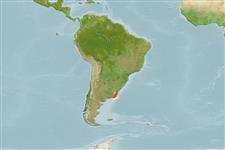Environment: milieu / climate zone / depth range / distribution range
Ecología
marino demersal; oceanodromo (Ref. 51243); rango de profundidad 1 - 150 m (Ref. 114953). Subtropical; 24°S - 41°S, 63°W - 55°W (Ref. 114953)
Western South Atlantic: From Rio de Janeiro to Argentina.
Tamaño / Peso / Age
Maturity: Lm ? range ? - ? cm
Max length : 138 cm TL macho / no sexado; (Ref. 57911); common length : 60.0 cm TL macho / no sexado; (Ref. 6077)
Nostrils are longer, crown is flat transversely or even slightly convex, tubercles in median row are larger, thorn like, numerous. Origin of first dorsal is posterior to the tips of pelvic fins, equal to the base of first dorsal. Upper surface uniform olive gray or chocolate brown, without pale or dark markings. Snout with an oval sooty patch (Ref. 6902).
Found from the coast line to the continental edge. Females mature at ca. 90 cm TL (Ref. 114953). Feeds on crustaceans, cephalopods, polychaetes and small fishes. Ovoviviparous (Ref. 50449). Produces litters of 4-12 pups (Ref. 114953).
Life cycle and mating behavior
Madurez | Reproducción | Puesta | Huevos | Fecundidad | Larva
Exhibit ovoviparity (aplacental viviparity), with embryos feeding initially on yolk, then receiving additional nourishment from the mother by indirect absorption of uterine fluid enriched with mucus, fat or protein through specialised structures (Ref. 50449).
Compagno, L.J.V., 1999. Checklist of living elasmobranchs. p. 471-498. In W.C. Hamlett (ed.) Sharks, skates, and rays: the biology of elasmobranch fishes. Johns Hopkins University Press, Maryland. (Ref. 35766)
IUCN Red List Status (Ref. 130435)
Threat to humans
Harmless
Human uses
Pesquerías: comercial
Más información
ReferenciasAcuiculturaPerfil de acuiculturaRazasGenéticaElectrophoresesheritabilidadEnfermedadesProcesamientoNutrientsMass conversion
Herramientas
Special reports
Download XML
Fuentes de Internet
Estimates based on models
Preferred temperature (Ref.
123201): 11.6 - 22.7, mean 15.6 °C (based on 248 cells).
Phylogenetic diversity index (Ref.
82804): PD
50 = 0.5039 [Uniqueness, from 0.5 = low to 2.0 = high].
Bayesian length-weight: a=0.00282 (0.00135 - 0.00588), b=3.12 (2.95 - 3.29), in cm total length, based on LWR estimates for this Genus-body shape (Ref.
93245).
Nivel trófico (Ref.
69278): 3.8 ±0.49 se; based on food items.
Resiliencia (Ref.
120179): Muy bajo, población duplicada en un tiempo mínimo superior a 14 años (Fec=4-12).
Fishing Vulnerability (Ref.
59153): Very high vulnerability (83 of 100).
